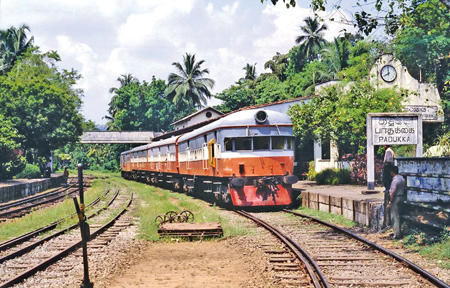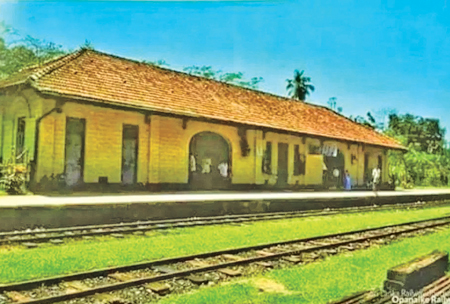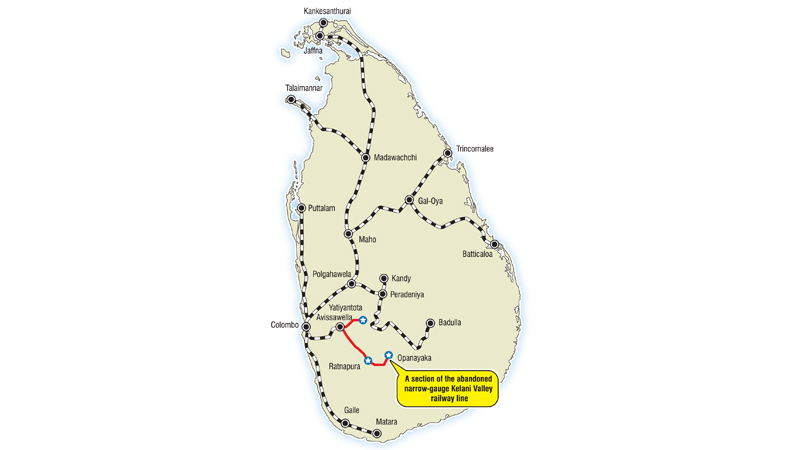 The Kelani Valley Line, one of Sri Lanka’s key railway routes, stretches from Colombo to Avissawella, following the Kelani River for much of its course. Serving passenger and freight transport, the line is essential for economic activity.
The Kelani Valley Line, one of Sri Lanka’s key railway routes, stretches from Colombo to Avissawella, following the Kelani River for much of its course. Serving passenger and freight transport, the line is essential for economic activity.
Recognising the need for modernisation, the Government has prioritised upgrading the Kelani Valley rail track to enhance service quality for commuters. President Anura Kumara Dissanayake unveiled plans to extend the rail track beyond Avissawella to Ratnapura as part of a broader rail network upgrade. The rail track once extended up to Opanaike, but later fell into disuse. This project assumes even more significance as the proposed Ruwanpura Expressway project has been suspended for the time being due to budgetary and land acquisition constraints.
President Dissanayake’s Budget included Rs. 3 billion to modernise public transport, including 100 new low-floor buses and investments in railway infrastructure to improve passenger and freight transport.
The President said that the construction of the rail track from Avissawella to Ratnapura needs a thorough study as there are many people and families who have been displaced and illegally established along the Kelani Valley rail track, and highlighted that the Government is unable to initiate the construction activities until identifying issues affecting them and finding solutions for them. He said that a Budget allocation of Rs. 250 million will be made to carry out the intended activities.
In railway services, Rs. 500 million will be allocated for the renovation of train compartments, and Rs. 250 million will be set apart for the local manufacturing of new compartments. The extension of the Kelani Valley rail track beyond Avissawella has the potential to dramatically improve Sri Lanka’s rail network, offering benefits for commuters, tourism, economic development, and sustainability in the region.
According to Railways General Manager Dhammika Jayasundara, the Railway Department has begun surveying along the section of the rail track from Avissawella.

A train at the Padukka railway station
The Avissawella to Ratnapura rail track is known for its difficult terrain due to the mountainous and hilly regions it passes through. As a result, the line had to traverse through numerous bends and bridges to navigate the landscape, known to have many of both, given the region’s rugged terrain and the engineering challenges of building a railway through the mountains. The speed of the trains will also be increased on this route from 40 km/h to 60 km/h. As part of the Kelani Valley Railway improvement project steps would be taken to reduce sharp bends on the rail track.
Engineering challenges
These engineering challenges are a testament to the complexity of building railways in mountainous regions and have contributed to the scenic beauty of the route, making it a popular travel experience. The proposed rail track extension plays a significant role in Sri Lanka’s tourism industry due to its scenic beauty and historical importance.
The Kelani Valley line expansion will connect the rail track further into the hill country. It will improve accessibility to remote regions. The President said this will be done in phases following a study. The goal is to expand the rail track to reach Ratnapura and potentially other towns further east.
The Avissawella to Ratnapura to Opanaike and Yatiyanthota rail tracks became non-operational due to the civil war-related sabotage, economic decline, shifting transport trends, and lack of resources for repairs and maintenance. The rail track was effectively abandoned in the 1990s and never fully recovered, becoming a piece of historical infrastructure that no longer served its intended purpose.
The rail network in Sri Lanka was largely developed during British colonial rule (1815-1948) to facilitate the transportation of goods, particularly tea, coffee, and other agricultural products, from the central highlands to the port of Colombo for export. The Avissawella to Ratnapura railway line was opened in the 1920s. The construction work on the rail track began in 1889 and was completed in 1894. It was part of the expansion of the railway system in the country. This particular section served as a key route to transport goods, including rubber, which was a significant export at the time.
The British rulers’ primary aim was to improve access to the Southern regions and facilitate the transportation of crops from Ratnapura, which was famous for gem mining and plantations. The Kelani Valley rail track, which was built in 1903 from Colombo to Yatiyanthota, was extended to Opanaike in 1919.
However, in 1975, the railway service was limited to Ratnapura, and by 1977, train services on the Kelani Valley line were restricted to Avissawella.
The distance between the rail track from Avissawella to Ratnapura was approximately 42 kilometres(about 26 miles). Ratnapura, known as the “City of Gems,” benefited from the rail connection. It was the major city for gem mining- especially for sapphires. The railway enabled easier transport of mined gems to Colombo for export.
The Kelani Valley Line begins in Colombo and passes through towns such as Pannipitiya, Kuruwita and Avissawella. The route is about 56 km from Colombo to Avissawella and is vital for commuters in suburban areas, along with providing access to nearby tourist destinations.
Tourist destinations
Extending the line would make it easier for people to travel between Colombo, Avissawella, and more distant areas in the Sabaragamuwa Province. This would improve access to the region for both commuters and tourists.

The old Opanaike railway station
The extension would increase accessibility to tourist destinations such as Sinharaja Forest Reserve and Ratnapura. By connecting these areas with the Western Coast, it would support eco-tourism and help ease travel for tourists exploring the country’s natural beauty.
A major benefit of the extension is the potential to ease traffic congestion on the roads, particularly on the Colombo-Avissawella route. Sri Lanka faces growing traffic issues, and rail transport could offer an efficient alternative for long-distance travel, helping to reduce road congestion.
By providing an alternative to road transport, extending the Kelani Valley Line would help reduce carbon emissions and promote more sustainable travel options. The train could become a preferred mode of transport for both locals and tourists, reducing the environmental impact compared to cars and buses.
The extension of the Kelani Valley Line program’s longer-term goal would also involve extending the line to connect with the Southern railway network or linking it with Kandy-Nuwara Eliya for more expansive travel options.
The project is likely to take place in multiple stages to make it manageable and cost-effective. Each phase would be implemented based on funding availability, demand, and logistical considerations, ensuring that it becomes a part of the country’s broader transportation infrastructure.
Picturesque landscapes
The railway route passes through some of Sri Lanka’s most picturesque landscapes, including lush rainforests, waterfalls, rivers, and mountainous terrain. This makes it an attractive option for tourists seeking an immersive experience in nature. The train rides offer breathtaking views.
The train journey through the region is especially popular among nature lovers, photographers, and those seeking a tranquil escape. It’s a great way for tourists to experience Sri Lanka’s natural beauty without the need for strenuous hikes.
The rail track connects to areas that are close to tourist hotspots such as Ratnapura, attracting visitors interested in Sri Lanka’s gem trade and history. The nearby Sinharaja Forest Reserve, a UNESCO World Heritage site, is a popular destination for eco-tourism and wildlife enthusiasts.
The route itself – from Avissawella to Ratnapura up to Opanaike is part of the country’s colonial heritage. The British colonial era influence on the construction of the railway system is a point of interest for history and heritage tourists. The train stations along the route are part of the historical narrative of Sri Lanka’s development during the late 19th century.
The proposed Avissawella to Ratnapura rail track is an integral part of Sri Lanka’s tourism infrastructure, helping to connect tourists with nature, culture, and history. It serves as a functional route for local travel and an attractive experience for those seeking to explore the island’s unique landscapes.




